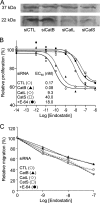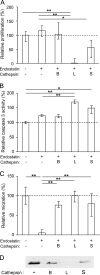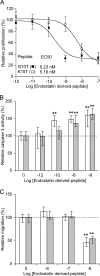Cysteine cathepsins S and L modulate anti-angiogenic activities of human endostatin
- PMID: 21896479
- PMCID: PMC3199463
- DOI: 10.1074/jbc.M111.284869
Cysteine cathepsins S and L modulate anti-angiogenic activities of human endostatin
Abstract
Human endostatin, a potent anti-angiogenic protein, is generated by release of the C terminus of collagen XVIII. Here, we propose that cysteine cathepsins are involved in both the liberation and activation of bioactive endostatin fragments, thus regulating their anti-angiogenic properties. Cathepsins B, S, and L efficiently cleaved in vitro FRET peptides that encompass the hinge region corresponding to the N terminus of endostatin. However, in human umbilical vein endothelial cell-based assays, silencing of cathepsins S and L, but not cathepsin B, impaired the generation of the ∼22-kDa endostatin species. Moreover, cathepsins L and S released two peptides from endostatin with increased angiostatic properties and both encompassing the NGR sequence, a vasculature homing motif. The G10T peptide (residues 1455-1464: collagen XVIII numbering) displayed compelling anti-proliferative (EC(50) = 0.23 nm) and proapoptotic properties. G10T inhibited aminopeptidase N (APN/CD13) and reduced tube formation of endothelial cells in a manner similar to bestatin. Combination of G10T with bestatin resulted in no further increase in anti-angiogenic activity. Taken together, these data suggest that endostatin-derived peptides may represent novel molecular links between cathepsins and APN/CD13 in the regulation of angiogenesis.
Figures







Similar articles
-
Genotyping and functional analysis of the D104N variant of human endostatin.Cancer Biol Ther. 2004 Dec;3(12):1298-303. doi: 10.4161/cbt.3.12.1453. Epub 2004 Dec 16. Cancer Biol Ther. 2004. PMID: 15662127
-
Addition of an aminopeptidase N-binding sequence to human endostatin improves inhibition of ovarian carcinoma growth.Cancer. 2005 Jul 15;104(2):321-31. doi: 10.1002/cncr.21149. Cancer. 2005. PMID: 15952188 Free PMC article.
-
Generation of biologically active endostatin fragments from human collagen XVIII by distinct matrix metalloproteases.Exp Cell Res. 2005 Jul 15;307(2):292-304. doi: 10.1016/j.yexcr.2005.03.021. Exp Cell Res. 2005. PMID: 15950618
-
Collagen XVIII/endostatin structure and functional role in angiogenesis.Cell Struct Funct. 2000 Apr;25(2):97-101. doi: 10.1247/csf.25.97. Cell Struct Funct. 2000. PMID: 10885579 Review.
-
Endostatin signaling and regulation of endothelial cell-matrix interactions.Adv Cancer Res. 2005;94:197-229. doi: 10.1016/S0065-230X(05)94005-0. Adv Cancer Res. 2005. PMID: 16096002 Review.
Cited by
-
Aminopeptidase N1 (EtAPN1), an M1 metalloprotease of the apicomplexan parasite Eimeria tenella, participates in parasite development.Eukaryot Cell. 2014 Jul;13(7):884-95. doi: 10.1128/EC.00062-14. Epub 2014 May 16. Eukaryot Cell. 2014. PMID: 24839124 Free PMC article.
-
Helicobacter pylori and gastric cancer: a lysosomal protease perspective.Gastric Cancer. 2022 Mar;25(2):306-324. doi: 10.1007/s10120-021-01272-8. Epub 2021 Dec 16. Gastric Cancer. 2022. PMID: 34918208 Free PMC article. Review.
-
Pericellular proteolysis in cancer.Genes Dev. 2014 Nov 1;28(21):2331-47. doi: 10.1101/gad.250647.114. Genes Dev. 2014. PMID: 25367033 Free PMC article. Review.
-
Hold on or Cut? Integrin- and MMP-Mediated Cell-Matrix Interactions in the Tumor Microenvironment.Int J Mol Sci. 2020 Dec 28;22(1):238. doi: 10.3390/ijms22010238. Int J Mol Sci. 2020. PMID: 33379400 Free PMC article. Review.
-
Endothelial Basement Membrane Components and Their Products, Matrikines: Active Drivers of Pulmonary Hypertension?Cells. 2020 Sep 3;9(9):2029. doi: 10.3390/cells9092029. Cells. 2020. PMID: 32899187 Free PMC article. Review.
References
-
- O'Reilly M. S., Boehm T., Shing Y., Fukai N., Vasios G., Lane W. S., Flynn E., Birkhead J. R., Olsen B. R., Folkman J. (1997) Cell 88, 277–285 - PubMed
-
- Marneros A. G., Olsen B. R. (2001) Matrix Biol. 20, 337–345 - PubMed
-
- Ling Y., Yang Y., Lu N., You Q. D., Wang S., Gao Y., Chen Y., Guo Q. L. (2007) Biochem. Biophys. Res. Commun. 361, 79–84 - PubMed
-
- Dhanabal M., Volk R., Ramchandran R., Simons M., Sukhatme V. P. (1999) Biochem. Biophys. Res. Commun. 258, 345–352 - PubMed
-
- Dixelius J., Cross M., Matsumoto T., Sasaki T., Timpl R., Claesson-Welsh L. (2002) Cancer Res. 62, 1944–1947 - PubMed
Publication types
MeSH terms
Substances
LinkOut - more resources
Full Text Sources
Other Literature Sources
Miscellaneous

